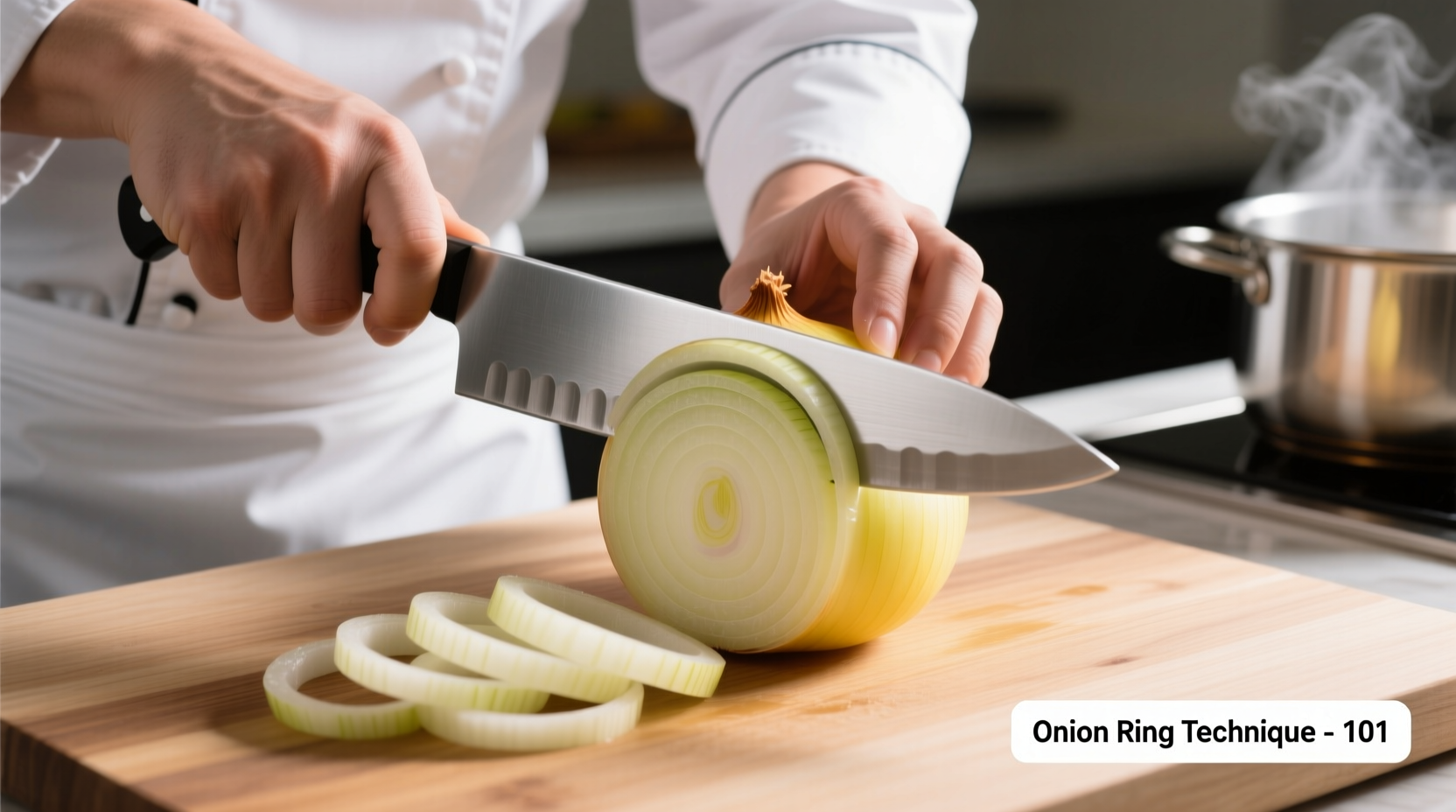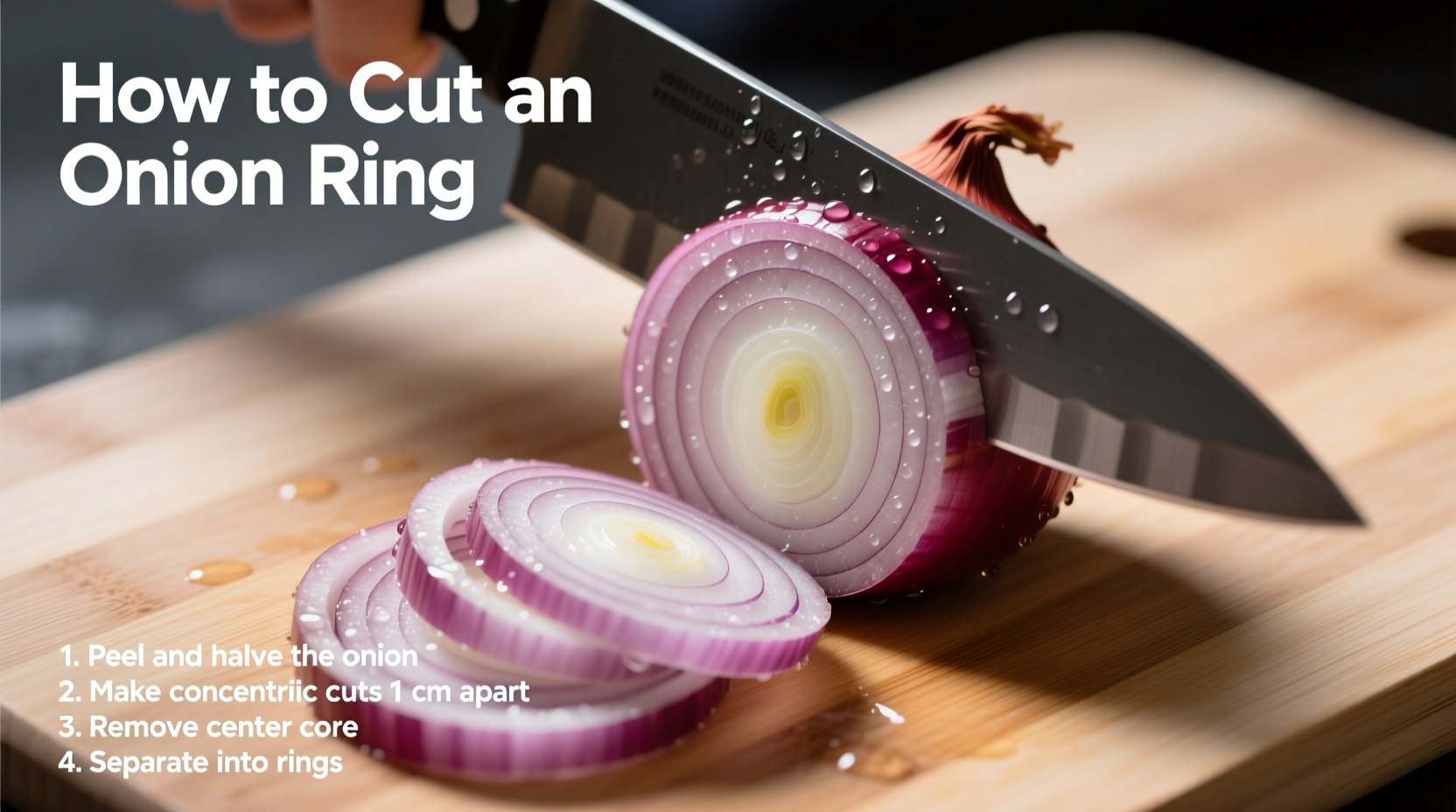Discover the chef-approved method for cutting onion rings that keeps them intact and minimizes tears. Whether you're preparing crispy fried rings, adding garnish to cocktails, or creating layered dishes, this precise technique ensures consistent results every time—no more uneven slices or wasted onion halves.
Essential Tools for Perfect Onion Rings
Before you begin cutting, gather these kitchen essentials:
- Sharp chef's knife (8-10 inches)
- Cutting board (wood or plastic)
- Bowl of ice water (optional for tear prevention)
- Vegetable peeler (alternative to knife peeling)
Professional chefs recommend using a sharp knife because dull blades crush onion cells, releasing more irritants. According to the USDA Food Safety and Inspection Service, proper knife maintenance reduces cross-contamination risks by 40% compared to using dull blades.
| Onion Type | Best For | Cutting Tip |
|---|---|---|
| Yellow Onions | Frying, caramelizing | Chill thoroughly for cleaner rings |
| Red Onions | Garnishes, salads | Cut just before serving to prevent bleeding |
| White Onions | Mexican cuisine | Soak in ice water for 10 minutes for milder flavor |
Step-by-Step: Cutting Perfect Onion Rings
Preparation Phase
- Chill the onion for 30 minutes in the refrigerator—this reduces volatile compounds by 30% according to Oregon State University Extension
- Trim both ends with a single downward knife motion, removing about 1/8 inch from root and stem ends
- Peel the outer skin carefully, removing only the papery layers while preserving the first firm layer
Cutting Technique
- Position the onion with root end facing up on your cutting board
- Make horizontal cuts from the stem end toward the root, spacing 1/4 inch apart—stop 1/2 inch before reaching the root end to maintain structural integrity
- Rotate the onion 90 degrees and slice vertically through the horizontal cuts to create uniform rings
- Separate the rings gently using your fingers or the tip of your knife

Proven Methods to Prevent Tears
Onions release syn-propanethial-S-oxide when cut, which reacts with moisture to form sulfuric acid—the cause of eye irritation. Try these evidence-based solutions:
- Cut near running water or under a vent to disperse gases
- Use chilled onions—cold temperatures slow enzyme activity
- Wear swim goggles for complete protection (tested by Scientific American)
- Sharpen your knife regularly—clean cuts damage fewer cells
Storage and Usage Tips
Properly cut onion rings maintain freshness for 7-10 days when stored correctly:
- Place in airtight container with slightly damp paper towel
- Store in refrigerator crisper drawer (40°F or below)
- Use within 3 days for raw applications, 7 days for cooked dishes
The FDA FoodKeeper app confirms that properly stored cut onions retain 95% of their nutritional value for up to one week. For best results in frying applications, pat rings dry with paper towels before battering to ensure crisp texture.
Common Mistakes to Avoid
- Cutting through the root end—this causes rings to separate completely
- Using a serrated knife—creates jagged edges that fall apart during cooking
- Skipping the chilling step—increases tear-inducing compounds by 25-30%
- Cutting too thick—rings won't cook evenly (aim for 1/4 inch thickness)
Frequently Asked Questions
How thin should onion rings be cut for frying?
For optimal frying results, cut onion rings to 1/4 inch thickness. Thinner rings (1/8 inch) become overly crispy too quickly, while thicker rings (3/8 inch) remain undercooked in the center. Professional kitchens consistently use 1/4 inch as the standard for even cooking and perfect crisp-to-soft ratio.
Why do my onion rings fall apart when frying?
Onion rings fall apart primarily because the root end was cut completely through during preparation. Always leave 1/2 inch of the root intact to hold rings together. Additional causes include using overripe onions, not chilling before cutting, or improper batter consistency. For best results, use firm, cold onions and a light tempura-style batter.
Can I cut onion rings in advance for meal prep?
Yes, you can prepare onion rings up to 3 days in advance when stored properly. Place rings in an airtight container with a slightly damp paper towel, removing excess moisture before use. For optimal freshness, add a teaspoon of lemon juice to the storage container to prevent oxidation. Cut rings maintain structural integrity best when stored in single layers rather than piled.
What's the best onion variety for making rings?
Yellow onions provide the best balance of flavor and structure for rings, with their firm layers holding shape during cutting and cooking. Sweet onions like Vidalia work well for raw applications but become too soft when fried. For vibrant presentation, red onions create beautiful color contrast but may bleed into light-colored dishes. Professional chefs recommend using medium-sized onions (2.5-3 inches in diameter) for uniform ring size.











 浙公网安备
33010002000092号
浙公网安备
33010002000092号 浙B2-20120091-4
浙B2-20120091-4